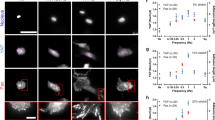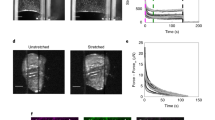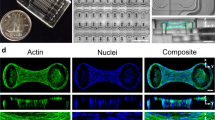Abstract
With every beat of the heart, inflation of the lung or peristalsis of the gut, cell types of diverse function are subjected to substantial stretch. Stretch is a potent stimulus for growth, differentiation, migration, remodelling and gene expression1,2. Here, we report that in response to transient stretch the cytoskeleton fluidizes in such a way as to define a universal response class. This finding implicates mechanisms mediated not only by specific signalling intermediates, as is usually assumed, but also by non-specific actions of a slowly evolving network of physical forces. These results support the idea that the cell interior is at once a crowded chemical space3 and a fragile soft material in which the effects of biochemistry, molecular crowding and physical forces are complex and inseparable, yet conspire nonetheless to yield remarkably simple phenomenological laws. These laws seem to be both universal and primitive, and thus comprise a striking intersection between the worlds of cell biology and soft matter physics.
This is a preview of subscription content, access via your institution
Access options
Subscribe to this journal
Receive 51 print issues and online access
$199.00 per year
only $3.90 per issue
Buy this article
- Purchase on Springer Link
- Instant access to full article PDF
Prices may be subject to local taxes which are calculated during checkout




Similar content being viewed by others
References
Vogel, V. & Sheetz, M. Local force and geometry sensing regulate cell functions. Nature Rev. Mol. Cell Biol. 7, 265–275 (2006)
Ingber, D. E. & Tensegrity, I. I. How structural networks influence cellular information processing networks. J. Cell Sci. 116, 1397–1408 (2003)
Minton, A. P. How can biochemical reactions within cells differ from those in test tubes? J. Cell Sci. 119, 2863–2869 (2006)
Mason, T. G. & Weitz, D. A. Linear viscoelasticity of colloidal hard sphere suspensions near the glass transition. Phys. Rev. Lett. 75, 2770–2773 (1995)
Sollich, P., Lequeux, F., Hebraud, P. & Cates, M. E. Rheology of soft glassy materials. Phys. Rev. Lett. 78, 2020–2023 (1997)
Cloitre, M., Borrega, R. & Leibler, L. Rheological aging and rejuvenation in microgel pastes. Phys. Rev. Lett. 85, 4819–4822 (2000)
Viasnoff, V. & Lequeux, F. Rejuvenation and overaging in a colloidal glass under shear. Phys. Rev. Lett. 89, 065701 (2002)
Corwin, E. I., Jaeger, H. M. & Nagel, S. R. Structural signature of jamming in granular media. Nature 435, 1075–1078 (2005)
Johnson, P. A. & Jia, X. Nonlinear dynamics, granular media and dynamic earthquake triggering. Nature 437, 871–874 (2005)
Matthews, B. D., Overby, D. R., Mannix, R. & Ingber, D. E. Cellular adaptation to mechanical stress: role of integrins, Rho, cytoskeletal tension and mechanosensitive ion channels. J. Cell Sci. 119, 508–518 (2006)
Lau, A. W., Hoffman, B. D., Davies, A., Crocker, J. C. & Lubensky, T. C. Microrheology, stress fluctuations, and active behavior of living cells. Phys. Rev. Lett. 91, 198101 (2003)
Fabry, B. et al. Scaling the microrheology of living cells. Phys. Rev. Lett. 87, 148102 (2001)
Fabry, B. et al. Time scale and other invariants of integrative mechanical behavior in living cells. Phys. Rev. E 68, 041914 (2003)
Alcaraz, J. et al. Microrheology of human lung epithelial cells measured by atomic force microscopy. Biophys. J. 84, 2071–2079 (2003)
Trepat, X. et al. Viscoelasticity of human alveolar epithelial cells subjected to stretch. Am. J. Physiol. Lung Cell. Mol. Physiol. 287, L1025–L1034 (2004)
Bursac, P. et al. Cytoskeletal remodelling and slow dynamics in the living cell. Nature Mater. 4, 557–561 (2005)
Deng, L. et al. Fast and slow dynamics of the cytoskeleton. Nature Mater. 5, 636–640 (2006)
Gardel, M. L. et al. Elastic behavior of cross-linked and bundled actin networks. Science 304, 1301–1305 (2004)
Storm, C., Pastore, J. J., MacKintosh, F. C., Lubensky, T. C. & Janmey, P. A. Nonlinear elasticity in biological gels. Nature 435, 191–194 (2005)
Fredberg, J. J. et al. Airway smooth muscle, tidal stretches, and dynamically determined contractile states. Am. J. Respir. Crit. Care Med. 156, 1752–1759 (1997)
Hoffman, B. D., Massiera, G., Van Citters, K. M. & Crocker, J. C. The consensus mechanics of cultured mammalian cells. Proc. Natl Acad. Sci. USA 103, 10259–10264 (2006)
Miguel, M. C. & Zapperi, S. Materials science. Fluctuations in plasticity at the microscale. Science 312, 1151–1152 (2006)
Bulatov, V. V. & Argon, A. S. A stochastic-model for continuum elastoplastic behavior. 2. A study of the glass-transition and structural relaxation. Model. Simul. Mater. Sci. Eng. 2, 185–202 (1994)
Brujic, J., Hermans, R. I., Walther, K. A. & Fernandez, J. M. Single-molecule force spectroscopy reveals signatures of glassy dynamics in the energy landscape of ubiquitin. Nature Phys. 2, 282–286 (2006)
Moazzam, F., DeLano, F. A., Zweifach, B. W. & Schmid-Schonbein, G. W. The leukocyte response to fluid stress. Proc. Natl Acad. Sci. USA 94, 5338–5343 (1997)
Yap, B. & Kamm, R. D. Mechanical deformation of neutrophils into narrow channels induces pseudopod projection and changes in biomechanical properties. J. Appl. Physiol. 98, 1930–1939 (2005)
Kozlov, M. M. & Bershadsky, A. D. Processive capping by formin suggests a force-driven mechanism of actin polymerization. J. Cell Biol. 167, 1011–1017 (2004)
Stamenovic, D., Suki, B., Fabry, B., Wang, N. & Fredberg, J. J. Rheology of airway smooth muscle cells is associated with cytoskeletal contractile stress. J. Appl. Physiol. 96, 1600–1605 (2004)
Rosenblatt, N., Alencar, A. M., Majumdar, A., Suki, B. & Stamenovic, D. Dynamics of prestressed semiflexible polymer chains as a model of cell rheology. Phys. Rev. Lett. 97, 168101 (2006)
Kirschner, M. W. & Gerhart, J. C. The Plausibility of Life: Resolving Darwin’s Dilemma (Yale Univ., New Haven, 2005)
Acknowledgements
These studies were supported by grants from National Institutes of Health and from the Spanish Ministries of Education and Science and Health. We thank R. Panettieri for providing cells, and R. Farré, D. Fletcher, F. Ritort and V. Viasnoff for discussions.
Author Contributions X.T. and J.J.F. designed research and wrote the manuscript. J.P.B. conducted the theoretical analysis. X.T. and D.N. designed and implemented the experimental system. X.T., L.D. and S.S.A. optimized experimental conditions and treatments. W.T.G. and D.J.T. helped to design experimental protocols and interpret data. D.J.T. provided cells and reagents. X.T. performed all stretch experiments and data analysis. J.J.F. oversaw the project.
Author information
Authors and Affiliations
Corresponding author
Ethics declarations
Competing interests
Reprints and permissions information is available at www.nature.com/reprints. The authors declare no competing financial interests.
Supplementary information
Supplementary Information
This file contains Supplementary Notes with Supplementary Figures S1-S9 and additional references. (PDF 1165 kb)
Rights and permissions
About this article
Cite this article
Trepat, X., Deng, L., An, S. et al. Universal physical responses to stretch in the living cell. Nature 447, 592–595 (2007). https://doi.org/10.1038/nature05824
Received:
Accepted:
Issue Date:
DOI: https://doi.org/10.1038/nature05824
This article is cited by
-
How multiscale curvature couples forces to cellular functions
Nature Reviews Physics (2024)
-
Myosin and \(\upalpha\)-actinin regulation of stress fiber contractility under tensile stress
Scientific Reports (2023)
-
Mechanical stimulation devices for mechanobiology studies: a market, literature, and patents review
Bio-Design and Manufacturing (2023)
-
A coarse-grained approach to model the dynamics of the actomyosin cortex
BMC Biology (2022)
-
Viscoelastic parameterization of human skin cells characterize material behavior at multiple timescales
Communications Biology (2022)
Comments
By submitting a comment you agree to abide by our Terms and Community Guidelines. If you find something abusive or that does not comply with our terms or guidelines please flag it as inappropriate.



